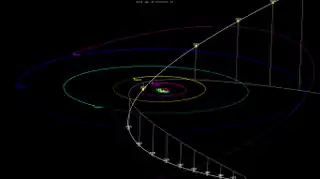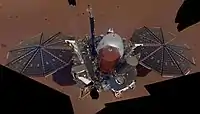C/2017 U7 (PanSTARRS)
C/2017 U7 (PanSTARRS) is a hyperbolic comet (previously classified as A/2017 U7, a hyperbolic asteroid), first observed on 29 October 2017 by astronomers of the Pan-STARRS facility at Haleakala Observatory, Hawaii, United States when the object was 7.8 AU (1.2 billion km) from the Sun.[1] Despite being discovered only 10 days after interstellar asteroid 1I/'Oumuamua, it was not announced until March 2018 (along with C/2018 C2 (Lemmon), which was believed to be another hyperbolic asteroid at the time) as its orbit is not strongly hyperbolic beyond most Oort Cloud comets.[2] Based on the absolute magnitude of 10.6, it may measure tens of kilometers in diameter.[5] As of August 2018, there is only 1 hyperbolic asteroid known, ʻOumuamua,[6] but hundreds of hyperbolic comets are known.[7]
 Trajectory through solar system | |
| Discovery [1][2] | |
|---|---|
| Discovered by | Pan-STARRS |
| Discovery site | Haleakala Obs. |
| Discovery date | 29 October 2017 |
| Designations | |
| C/2017 U7 | |
| P10EwQh, A/2017 U7 | |
| hyperbolic comet [3] | |
| Orbital characteristics [3] | |
| Epoch 29 November 2017 (JD 2458086.5) | |
| Uncertainty parameter n.a. | |
| Observation arc | 176 days |
| Earliest precovery date | 18 August 2017[1] |
| Perihelion | 6.4187±0.0008 AU |
| −3700±300 AU[lower-alpha 1] | |
| Eccentricity | 1.0018±0.0001 1.000008 (Barycentric epoch 2200)[4] |
| ~800000 years (inbound barycentric epoch 2000) | |
| n.a. | |
| 0° 0m 0.016s / day | |
| Inclination | 142.6390° |
| 276.217° | |
| 325.95° | |
| Earth MOID | 5.468 AU |
| Jupiter MOID | 1.635 AU |
| Physical characteristics | |
| Dimensions | 13.5–59 km (assumed)[5] |
| 20.6 (March 2018) | |
| 10.6±0.62 | |
Orbit
Although C/2017 U7's orbit is no longer bound to the Solar System, unlike ʻOumuamua, it is probably not an interstellar object. It had an inbound orbital period of roughly 800000 years. Its point of origin is inclined only 3.5 degrees from the galactic plane, but its aphelion points roughly to the Galactic anticenter, so if it did somehow originate from interstellar space with a typical Solar System velocity (which is highly unlikely) it would have been travelling on an unusual orbit directly into the galactic core from beyond the Sun's orbit around the Milky Way.
A barycentric orbit of C/2017 U7, however, shows that it is only a very distant Solar System object, approaching as far as 16,000 ± 1,000 AU from the Sun, around the distance of the Oort Cloud. It had an inbound orbital period of roughly 740,000 years until the current approach to the Solar System, where perturbations show it on an extremely weak hyperbolic trajectory after leaving the planetary region of the Solar System.[4][8][lower-alpha 2] The barycentric eccentricity increases above 1 starting with an epoch of July 2022, reaching 1.0000088 once it gets beyond planetary perturbations.[4]
As of March 2018, C/2017 U7 is inbound 7.4 AU (1.1 billion km) from the Sun.[2] C/2017 U7 makes closest approach to the Sun on 10 September 2019 at a distance of 6.4 AU (outside of Jupiter's orbit).[3] Due to the orbital inclination, on 18 May 2020, the asteroid will be about 1.66 AU (248,000,000 km; 154,000,000 mi) from Jupiter,[3] generating a peak heliocentric eccentricity at 1.003.[lower-alpha 3] The dynamical analysis shows that the object has probably originated in the Oort cloud, however an interstellar origin cannot be discarded.[9]
 Path across sky
Path across sky Hyperbolic trajectory through solar system
Hyperbolic trajectory through solar system
Physical characterization
The spectra and the colors of the hyperbolic comet C/2017 U7 (PANSTARRS) are atypical and the feature and overall spectral shape can be reproduced by laboratory spectra of kerite, a template for aliphatic-rich hydrocarbons that has been previously identified in NIR cometary spectra absorptions.[9]
Notes
- Objects on hyperbolic trajectories have negative semimajor axis, giving them a positive orbital energy.
- Soln.date: 2018-Mar-04: EC= 1.000008 (Barycentric epoch 2200) Using a heliocentric orbit allows Jupiter's 12 year orbit to drop the eccentricity below 1 centered around the years 2042, 2054, 2066, etc. For example in July 2042 the heliocentric eccentricity is 0.99927.
- Soln.date: 2018-Mar-04: EC= 1.003046 (Heliocentric epoch 2020-May-19)
References
- "A/2017 U7". Minor Planet Center. Retrieved 5 March 2018.
- "MPEC 2018-E17 : A/2017 U7". IAU Minor Planet Center. 4 March 2018. Retrieved 4 March 2018. (AK17U070)
- "JPL Small-Body Database Browser: (A/2017 U7)" (2018-02-10 last obs.). Jet Propulsion Laboratory. Archived from the original on 5 March 2018. Retrieved 5 March 2018.
- Horizons output. "Barycentric Osculating Orbital Elements for Asteroid (A/2017 U7)". JPL Solar System Dynamics. Retrieved 5 March 2018. (Solution using the Solar System's Barycenter. Select Ephemeris Type: Elements and Center: @0)
- "Asteroid Size Estimator". Jet Propulsion Laboratory. Retrieved 5 March 2018.
- "JPL Small-Body Database Search Engine: orbital class Hyperbolic Asteroid (HYA)". Jet Propulsion Laboratory Solar System Dynamics. Retrieved 12 August 2018.
- de la Fuente Marcos, Carlos; de la Fuente Marcos, Raúl; Aarseth, Sverre J. (6 February 2018). "Where the Solar system meets the solar neighbourhood: patterns in the distribution of radiants of observed hyperbolic minor bodies". Monthly Notices of the Royal Astronomical Society Letters. 476 (1): L1–L5. arXiv:1802.00778. Bibcode:2018MNRAS.476L...1D. doi:10.1093/mnrasl/sly019.
- Plait, Phil (6 March 2018). "AN ASTEROID IS ABOUT TO EMBARK ON A VERY LONG VOYAGE TO INTERSTELLAR SPACE". SyFyWire. Retrieved 6 March 2018.
- Santana, Marçal Evangelista; Carvano, Jorge M.; de Prá, Mario; de la Fuente Marcos, Raúl; Schambeau, Charles; Licandro, Javier; de la Fuente Marcos, Carlos; Souza-Feliciano, Ana Carolina; Pinilla-Alonso, Noemi (1 May 2022). "Physical and dynamical characterization of hyperbolic comet C/2017 U7 (PANSTARRS)". Icarus. 377 (1): 114834. Bibcode:2022Icar..37714834E. doi:10.1016/j.icarus.2021.114834. S2CID 246093558.
External links
- C/2017 U7 at the JPL Small-Body Database

